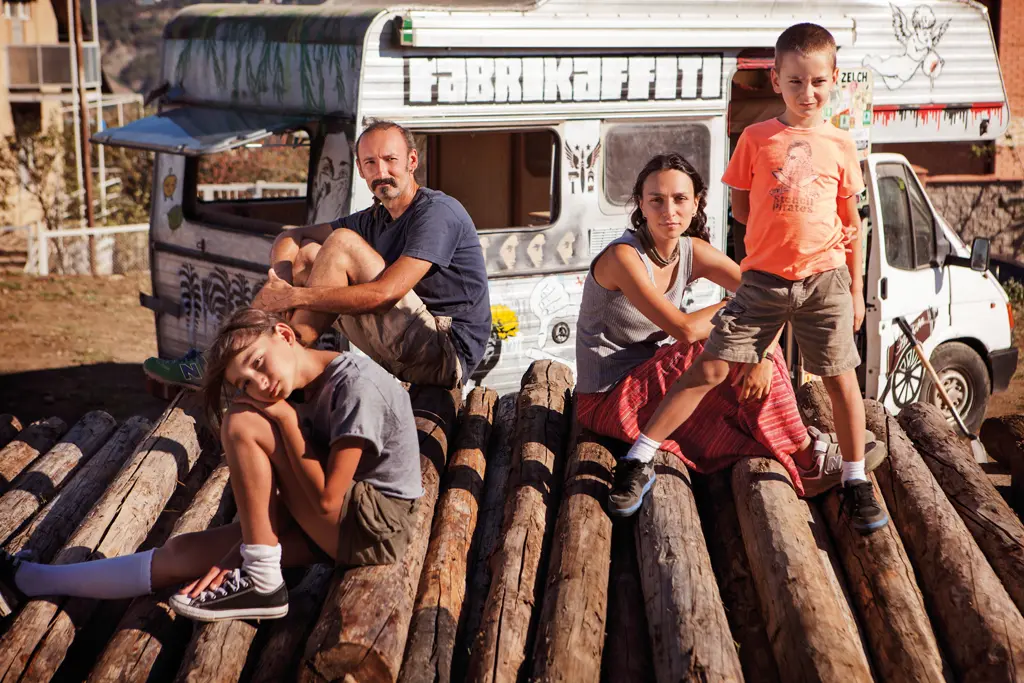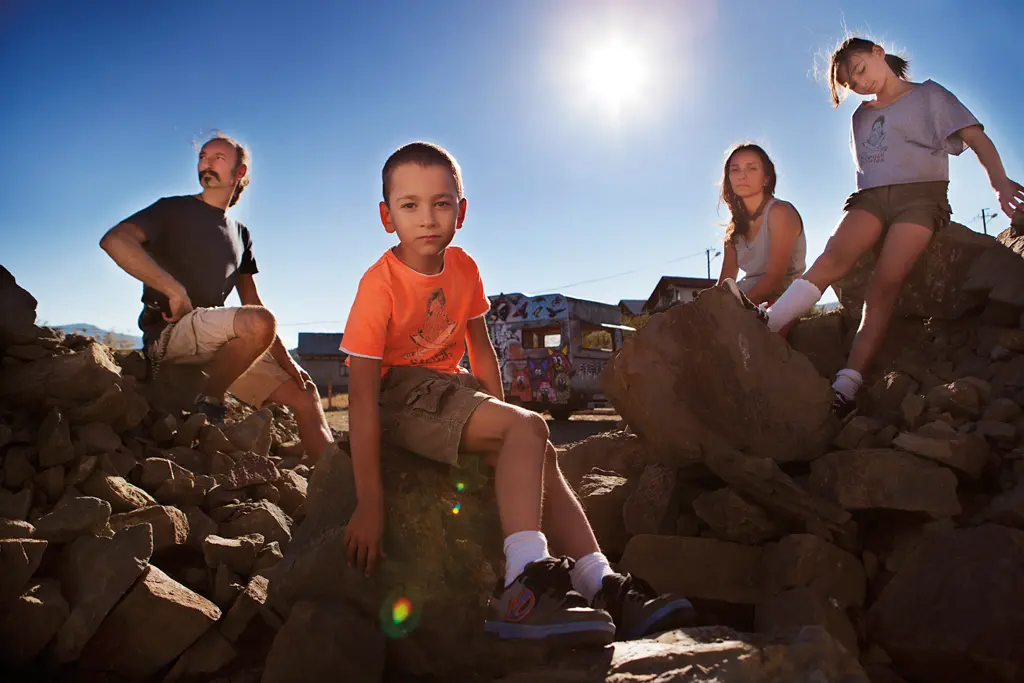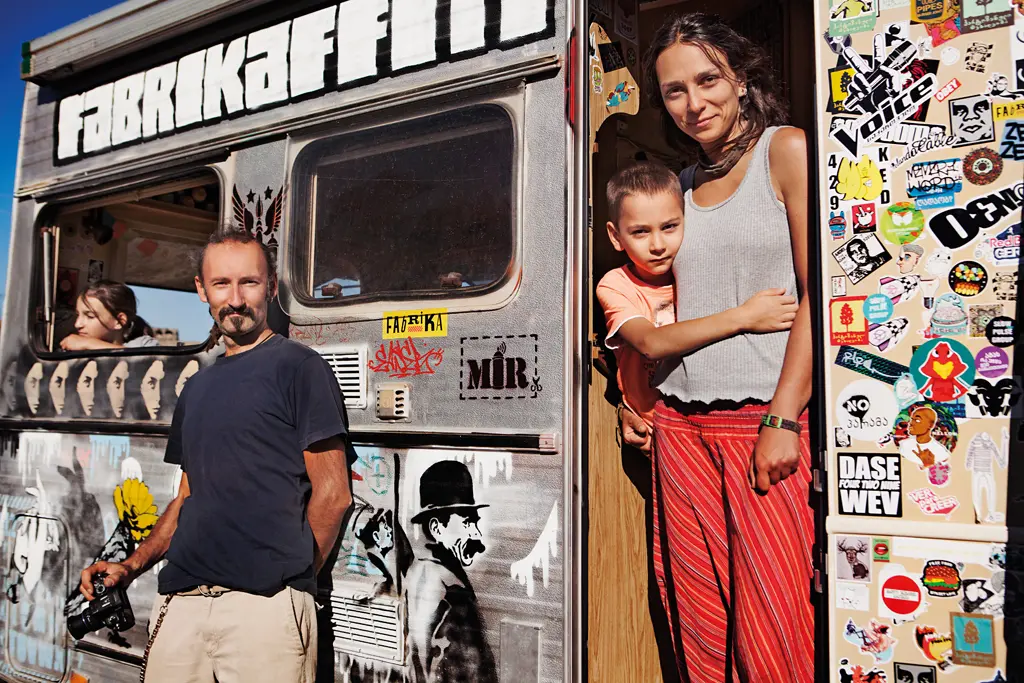
Putting on a House
15.11.2017 | 10 Min to readOne day, when hundred-year-old trees are cut down in your city, a gigantic pit is dug in the only park for miles, and a large concrete structure is set up in its place; when the most familiar view of your city is obscured by gray, non-descript buildings; when car exhaust comes in through the open window instead of air, leaving a heavy residue behind; and when you return home having gone out for a walk in sandals covered with dust up to your knees; when you no longer have a place on the sidewalk and the city begins to strangle you, and you spend sleepless nights planning how you will survive. Eventually, you slam your fists against it in exasperation, paint the walls, write letters, yell loudly, and yet nothing changes. So you shut your eyes and say that it is enough, and convince yourself that change must begin with you. All of this might prompt you to paint an elephant, moon, or tree on your house, to have a crescent-shaped window and small skylights of with cute geometric shapes. All this might also inspire you to choose a house that fits you like a favorite pair of jeans and to build this house on a piece of land where you will actually be able to breathe.
Maybe that’s when two guerrilla gardeners Miro Shengelaia and Elene Azmaiparashvili became land owners? A motorhome covered with their colorful inscriptions and stickers now stands on this parcel of land. The dirt, straw, and clay structure that will be built there will house Miro, Elene, their two children, two dogs, three guinea pigs and a cat. This is a house that will hold everyone, with its walls being erected by its owners' bare hands. A hulking crane, on which a concrete slab swings to and from, will not appear at this construction site. No. The house will be created from the earth and will be united with the earth in the end, as it will be alive like a human and mix into the soil like a human.
Elene, who has Ianto Evans' book sitting on her knees, says this is her wish. This is also Miro's desire. Miro is a man who first blew enormous soap bubbles at one of the peace rallies where the two, along with others, stood defending the city. Even now, as they tell this story, Miro and Elene stand at a rally with like-minded friends in front of the Tbilisi Mayor's Office.
“I am Tbilisi, I am Tbilisi, I am Tbilisi…”
The thick book that sits on Elene's knees is a book in which the author Ianto Evans teaches you how to build the kind of house that won't have a grandiose rampart surrounding it and enormous walls.


Miro: We needed some space. Us, the children, and the domestic animals. We began searching on the internet, looking around. In the beginning we just looked at simple designs, but one day we found the design of the cob and we liked the form of this structure. At that time we even knew that this dirt and clay house – a so-called cob – is a part of what is called eco-construction.
Elene: At the same time I love Antoni Gaudi. I love his interiors – Gaudi really guided through natural forms, he had never become rectilinear, with him there are curved forms going towards roundness. Eco-architecture taken from natural forms, especially buildings erected with sand and clay, are precisely characterized by this feature, this form. We began searching from here.
Miro: Then we saw that such a house has its name in English. The Georgian equivalent to cob might be... a mud brick house?
Elene: No, not entirely of mud brick, more like clay.
Miro: That also doesn’t fully express the essence to the end. The construction of houses of this type has recently become quite popular abroad. A cob, which we want to build, is made up of three components – clay, sand and straw – plus water. Up until now, we have had no information and knowledge of architecture or engineering.
And We ventured to do it because this house is not built – it’s sculpted. And in principle, every person, regardless of age, can participate in building it. Heavy equipment won't be used, the process is absolutely harmless to the surroundings. This kind of house can be created at minimal material costs with ecological, clean, and energy efficient materials.
Elene: Everything is written here in this book.
Miro: When we began reading the book, we soon realized that half the book was philosophy and offered few technical details. Building such a house is more an expression of independence or a statement.
When you really fall in love with something and are able to make something well, you naturally share it with others – it doesn't stay with only you. It is similar to what Ianto Evans, a famous landscape architect, ecologist, writer, and teacher did years ago – he wrote a book about building a house. Yet before that, he opened the door of a cob built with his own hands. It was the year 1989. North America. Ianto wasn't alone – he had Linda beside him. They built a house nearly free-of-cost using natural materials, and with the addition of some recycled stuff. The process can't be called construction however. It's more akin to sculpting like a sculptor. You measure it and fit it, as if you're planting a natural garden. And for this you use non-toxic, easily re-workable material.
Evans came up with a simple response to define a cob:
“What is this house? This is the dirt under your feet, mixed together with straw, sometimes clay and sand. You can use old stones or used bricks for a foundation. Just be creative. Your house can take a form [that is] desirable to you.”
And sometimes this form might even be like in a fairy-tale, like the portal to one of Tolkien's books, when you suddenly poke your head up in a hobbit's guest room and magical stories befall you. And don't be surprised – it is a house like others don't have. Like many have not chosen.


Miro: We also figured that since this house is being made from natural materials, if it were to be destroyed, it won't harm the environment. Such houses were built through similar technology in the bygone era of Georgia too. Mud brick houses.
Elene: Even in Africa they all had these kinds of houses, before the white man appeared there. It is warm in winter and cool in summer... I think we haven't gravitated towards this kind of house by chance. This is what I constantly carried inside me and wanted.
What is it that I want?
I want to exist on Earth (and the Earth has already shown us many times that people must hold their own ambitions back a little and not just think of themselves) in a way that if nothing good remains after me, I won't leave anything behind that is bad. It is directly written in this book that whoever builds such a house, goes to the place and meditates. It is written there: go and meditate. Go and imagine your future life on that parcel of land and how you will define where things will be organized. This is why this principle of construction is radically different – it gives you the ability to build and then think which room will be where, or at which place we must arrange an item. It is as if you're going to a rehearsal of your day – look, I got up in the morning, where would I like the bathroom to be today? When I return home in the evening, where do I want to sit down and work? This is how a space is created from the inside.
I fit my four walls to my way of life and not vice-versa. And I also like that a person grows closer to the environment during the construction process.
They see the sunrise and sunset better, predict the wind, which a person living in a modern apartment complex can't foresee.
Miro: The difference is also that ordinary construction requires more money and less time. Here it's the opposite – the expenses are less, but it takes a lot of time. We'll probably need two seasons. Spring and summer will be enough I think.
They will move there and they will do it soon, because Miro and Elene have made their choice. A workshop will be first made on the land and the workshop will gradually transform into a house. A motorhome that they acquired years ago already resides on their new land. A ‘house on wheels’ was their dream, and then one day by chance they stumbled upon it for a cheap price in Germany. They bought it. They traveled the country with this moving house. There was a vacation by the sea, they even stood at the Vake Park to guard it. They even used it as a studio for a television project. Now it has become a tenant, a part of their cob, that which until now they carried about with them like a snail. It was a family member just as much. Today however, Miro and Elene are drawn to used windows and poles like swallows, to items unfit to be used by someone else. Miro and Elene were compared to swallows by their small daughter when she returned from the village this summer. Some swallows had built a nest there.
Elene: To the majority of people, the things we collect for our home are probably viewed as trash. But when our house is built, we will show everyone how it is possible to use what everyone thought was trash. We will provide them an example. I know this house will be a support. With this house I'm not just leaving some walls to my children, but instead an idea, that I, not having contact with architecture and construction, was able to do it without taking loans from the bank and didn't change my life choice, and that through my labors and modest income, I was able to build this house.
Miro: We are also trying to put our energy into this land and we are trying to shape it. A home is a space that doesn't change, a place where you always return. The more energy you put into something made by hand, the same energy returns to you, if not more. David Chachanidze, another Georgian, was an example for us; he had already built a straw house in the Kakhetian village of Bakurtsikhe.
Elene: Yeah, we're still just talking theoretically and he carried his plan out. For this reason – that we're still at the beginning of the journey – I might have said no, but then I thought that I want people to see that another choice exists.
The city is also a house. However many kilometers you may distance yourself with your four walls and one roof, this city still remains your main house; main house with its own gray entrance halls. To this day Miro's stencils have not been removed from them – this began years ago. At that time, no one went out into the city streets at dawn with paints. Innovation – this was Miro's impulse. He usually painted in the morning. In the afternoon however, there was already talk of how this wall came to life at this certain spot. In some places with Elene's gaze, in some places with Einstein's appearance, in other places with a little prince... This resembled the times when you put up a poster in your room and tried to decorate it. Miro had this kind of dialogue with the city. Then, when this dialogue grew into a protest and guerrilla gardening, the essence of the stencils became more intense. Even the stencils gradually became fashionable. Street art was also another choice – a non-salon art having emerged from the gallery which you had to silently create at night – balancing on the verge of vandalism and creativity.
Miro: I want to further develop the genre in Georgia and create something like a small community where more young people will come and learn this technique. Paints will be sold. I think a development of awareness takes place through this as well; the idea that this city belongs to them. It is theirs, they must arrange it and make it beautiful. Someone may plant a tree, someone may create a painting, and so on.
Elene: Yet, recently it's as if all kinds of conventionalities are opening up. Today, art is already coming out on the street and becoming far more accessible. It's the same thing with music – more and more people are going out on the street and playing abroad. It's as if this is also a new expression where one makes a statement for free. This is an action, when you make something yourself. No one else can do this instead of me. I remember well, when Miro and I were fencing in our parcel of land, we were working together there and whoever passed close by said to themselves, “These two will be foreigners.” I want to say this too, through this interview: No, I'm a Georgian and this is another, but Georgian choice. And they can do the same thing if they desire it.
Miro: Our worldview might have been formed by a few years' absence from the country – we lived for a few years in Asia in Singapore and were always comparing this and that city to each other. I was surprised how a city may be so industrial and yet be so connected to nature and to the greenery. You would suddenly work your way down into the subway and find yourself in the 24th century. You would weasel your way back up and in a hundred meters, you encounter an untouched jungle.
Elene: Even the city planning… Today we were talking precisely about the types of infrastructure being developed on Lisi Lake, which on the one hand is not bad, because if construction changes the outskirts of the city, it’s always better. Yet in the end, the result is the same – the lisi-goers have to return into town via narrow streets.
Miro: But in Tbilisi such mistakes have already been made and they can't be changed in any way. Neither will the new residential or the shopping complexes be destroyed, nor that road widened which is already narrow, will be adjusted; and nor will a hundred-year-old tree cut down in greed, grow up in ten years.
Elene: Yes, we are told “that such mistakes have been made in the past, and that it is over, and that it can no longer be rectified.” No! This is not the way! Even today it is possible to re-plan things and correct them. This city will still withstand mistakes that have been made. But if it continues on like this, the city will not survive.
Miro: But look here, I think the events in Vake Park and the halting of the construction of the hotel there, was a victory. Today a patch of grass has grown in the pit where the construction was to have commenced. It's as if nature has returned to that location.
Elene: I always think that it isn't possible for a person to look at absolutely featureless, rectangular buildings and like them. Why don't more people protest this? They don't know, they can't put a name to it or express what they like or don’t like.
There have been other pursuits as well, deviations from the usual ways, when Miro became interested in aerial photography from the very beginning and became one of the first to begin this business in Georgia. The first attempt at using a digital camera in video production was his as well. He staged a joyful presentation of blowing big soap bubbles in this way – not with a soap solution bought at a store, but by making everything himself, including the stick and string. And when someone was the first to go through the city with a scooter – that was also Miro. Because it is comfortable. Because it is interesting. Because it is new. Because it is a change. Miro has simple answers.
The meeting of Miro and Elene was also a choice… almost 15 years ago. Elene has a simple response in regard to this choice – when your person comes, you simply must know him. Then you must cultivate love and along with all of this, you must remain free.
Free people can build a house with their own hands.
Photo: Khatuna Khutsishvili



